
French postcard by Croissant, Paris, no. 3664. Photo: Film Pathé. Publicity still for Le chemineau/The Tramp (Albert Capellani, 1905), based on the first part of 'Les misérables' in which Jean Valjean, who was granted lodging by the parish priest of a village, stole several silver candlesticks and escapes the arrest thanks to the false testimony of the priest. Unclear is who the actors are, but the sets were by Hugues Laurent. The film appeared in the 'Scènes dramatiques et réalistes (8ème Série)' by Pathé.
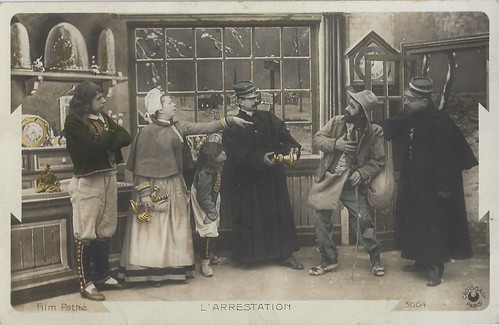
French postcard by Croissant, Paris, no. 3664. Photo: Film Pathé. Publicity still for Le chemineau/The Tramp (Albert Capellani, 1905), based on the first part of 'Les misérables'.
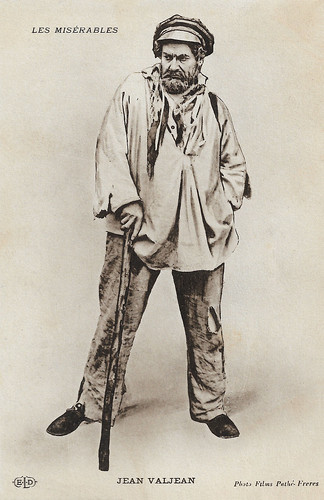
French postcard by ELD. Photo: Films Pathé-Frères. Henry Krauss as Jean Valjean in Les Misérables (Albert Capellani, 1913). Sent by mail in 1916. In this two-part silent film version, Henri Étiévant played Javert and Mistinguett appeared as Éponine Thénardier.

French postcard by E.L.D. Photo: Films Pathé Frères. Publicity still for Les Miserables (Albert Capellani, 1913), with Henry Krauss (left) as Jean Valjean, Léon Lérand as Gillesnormand, Marialise as Cosette, and Gabriel de Gravone as Marius. Caption: Les fiançailles de Marius et de Cosette (The betrothal of Marius and Cosette).
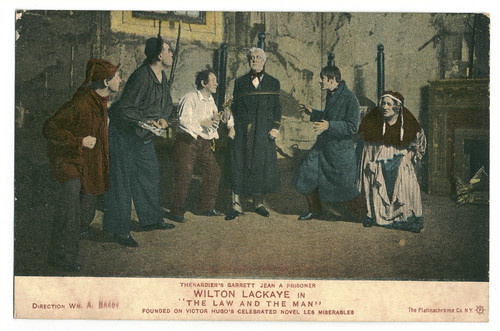
American postcard by the Platinachrome Company, New York. Wilton Lackaye in the stage production 'The Law and the Man' (1906-1907), directed by Wilton Lackaye and produced by William A. Brady. Collection: Manuel Palomino Arjona @ Flickr. The play was written by Lackaye, "founded on Victor Hugo's celebrated novel 'Les Misérables'". 'The Law and the Man' was presented at the Manhattan Theatre in New York from 20 December till February 1905 and counted 54 performances.
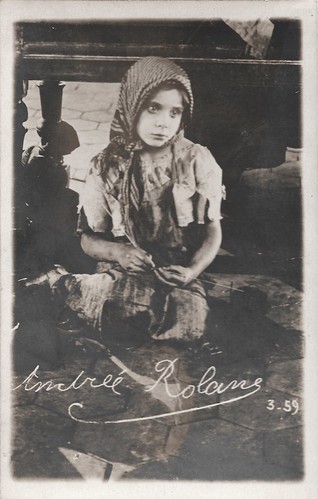
French postcard, no. 3.59. Andrée Rolane as Cosette in Les Misérables (Henri Fescourt, 1925). In this French silent film version Gabriel Gabrio starred as Jean Valjean.
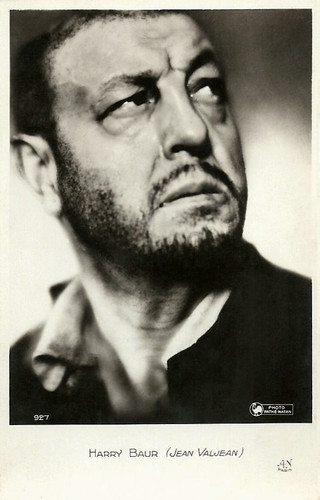
French postcard by A.N., Paris, no. 927. Photo Pathé Natan. Harry Baur as Jean Valjean in the 4½-hour French version Les Misérables (Raymond Bernard, 1934).

French postcard by A.N., Paris, no. 931. Photo Pathé Natan. Emile Génevois as Gavroche in Les Misérables (Raymond Bernard, 1934).
A force for good in the world that cannot escape his criminal past
'Les Misérables' began as a French historical novel by Victor Hugo, first published in 1862. Hugo's 'Les Misérables' is one of the greatest novels of the 19th century. Beginning in 1815 and culminating in the 1832 June Rebellion in Paris, the novel follows the lives and interactions of several characters, particularly the struggles of ex-convict Jean Valjean and his experience of redemption.
Hugo wrote towards the end in his novel that 'Les Misérables' is "a progress from evil to good, from injustice to justice, from falsehood to truth, from night to day, from appetite to conscience, from corruption to life; from bestiality to duty, from hell to heaven, from nothingness to God." Jean Valjean becomes a force for good in the world but cannot escape his criminal past. The novel as a whole is one of the longest ever written, with 655,478 words in the original French version. Hugo divided 'Les Misérables' into five volumes, each volume divided into several books, and subdivided into chapters, for a total of 48 books and 365 chapters. Each chapter is relatively short, commonly no longer than a few pages.
The appearance of the novel was a highly anticipated event as Victor Hugo was considered one of France's foremost poets in the middle of the nineteenth century. Critical reactions were wide-ranging and often negative. Some critics found the subject matter immoral, others complained of its excessive sentimentality, and others were disquieted by its apparent sympathy with the revolutionaries. The work was a commercial success and has been a popular book ever since it was published. Translated the same year it appeared in several foreign languages, it proved popular not only in France but around the world.
Since its original publication, 'Les Misérables' has been the subject of a large number of adaptations in numerous types of media, such as books, films, musicals, plays, and even games. Notable examples of these adaptations include the 1937 radio adaptation by Orson Welles, the 1980 stage musical, and the 2007 TV anime adaptation, by Studio Nippon Animation. The original French musical by Claude-Michel Schönberg (music), Alain Boublil and Jean-Marc Natel (original French lyrics), and Herbert Kretzmer (English lyrics) premiered in Paris in 1980 under the direction of Robert Hossein. Its English-language adaptation by producer Cameron Mackintosh has been running in London since October 1985, making it the longest-running musical in the West End.
And of course, there were many film and television adaptations, including the 1978 television film adaptation, starring Richard Jordan and Anthony Perkins, the 1982 film adaptation, directed by Robert Hossein, starring Lino Ventura and Michel Bouquet, the 1995 film, by Claude Lelouch, starring Jean-Paul Belmondo, the 1998 film, starring Liam Neeson and Geoffrey Rush, the 2000 TV miniseries, starring Gérard Depardieu and John Malkovich, and a 2018 British TV series by Andrew Davies, starring Dominic West, David Oyelowo and Lily Collins.

British postcard by Film weekly. Photo: Twentieth Century. Fredric March as Jean Valjean / Champmathieu in Les Misérables (Richard Boleslawski, 1935). Collection: Manuel Palomino Arjona @ Flickr. The film was nominated for Best Picture, Best Film Editing, and Best Assistant Director at the 8th Academy Awards.

Cameron Mitchell as Marius and Debra Paget as Cosette in Les Miserables (Lewis Milestone, 1952). Collection: Tommy A. @ Flickr.
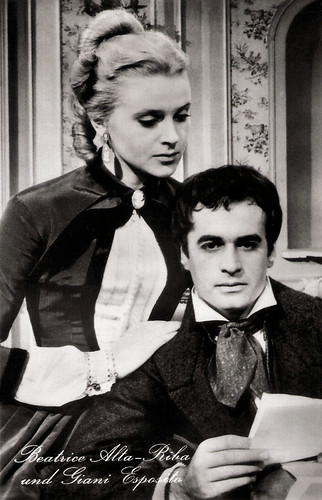
East-German postcard by VEB Progress Film-Vertrieb, no. 951, 1958. Photo: DEFA. Béatrice Altariba as Cosette and Giani Esposito as Marius in Les misérables (Jean-Paul Le Chanois, 1958). The film was a co-production of DEFA (East-Germany), P.A.C. (France), Serena (Italy) and Société Nouvelle Pathé Cinéma (France). This version had an international cast starring Jean Gabin, Bernard Blier, and Bourvil. Called "the most memorable film version", it was filmed in East Germany and was overtly political.
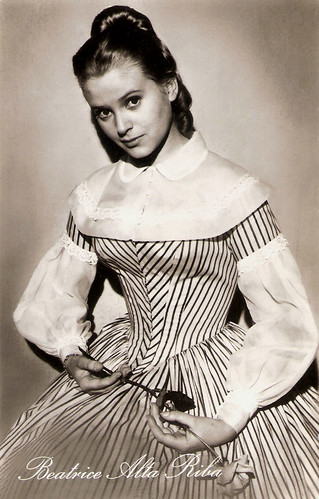
East-German postcard by VEB Progress Film-Vertrieb, no. 141/576, 1959. Photo: DEFA / Corbeau. Béatrice Altariba as Cosette in Les misérables (Jean-Paul Le Chanois, 1958).

Stage musical 'Les Misérables', directed by Trevor Nunn & John Caird at The Palace Theatre, London, in 1985. Collection: Manuel Palomino Arjona @ Flickr.

Stage musical 'Les Misérables' at the Kallang Theatre in Singapore in 1994. Caption: "Les Misérables. The world's most popular musical." Collection: Manuel Palomino Arjona @ Flickr.
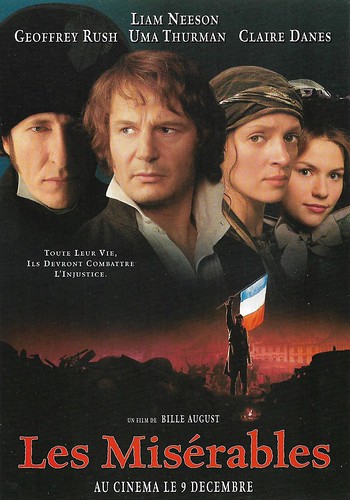
French postcard for the film Les Misérables (Bille August, 1998), starring Liam Neeson as Jean Valjean, Geoffrey Rush as Javert, Uma Thurman as Fantine, and Claire Danes as Cosette. The film was a British-American-German coproduction.

'Les Misérables' by Claude-Michel Schönberg & Alain Boublil in Theater (der Bundesstadt) Bonn (2003). Collection: Manuel Palomino Arjona @ Flickr.
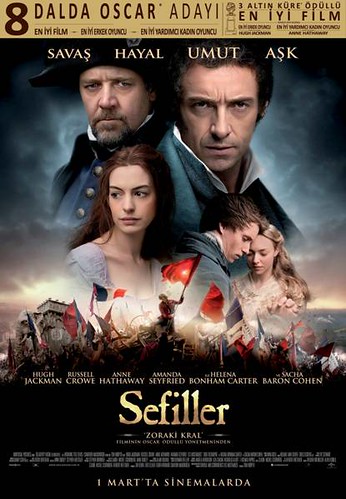
Turkish poster for Les Misérables (Tom Hooper, 2012), starring Hugh Jackson as Jean Valjean and Russell Crowe as Javert. The film was based on the original stage musical 'Les Misérables' by Claude-Michel Schönberg & Alain Boublil. Collection: Sinema Tutkusu @ Flickr.
Sources: Wikipedia, IBDB, and IMDb.
No comments:
Post a Comment